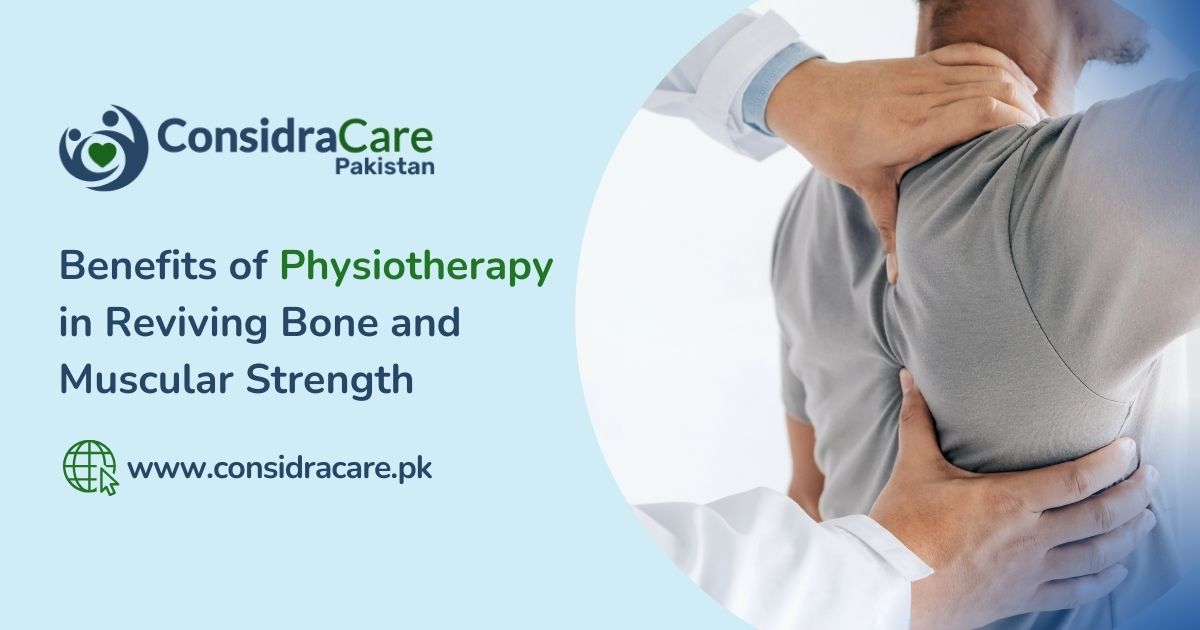Physiotherapy is a vital approach for restoring and enhancing bone and muscular strength. It offers a cost-effective and non-invasive holistic solution to physical damage caused by accidents or diseases. Interventions, such as personalized exercise programs, are designed to strengthen bones and muscles, enhance balance, and stability, and reduce the risk of injuries. By improving joint mobility and flexibility, physiotherapy contributes to better muscle performance, enabling individuals to perform daily activities with ease and confidence.
This article will revolve around the benefits of physiotherapy in reviving bone and muscular strength, highlighting the ways to help you regain vitality and maintain an active lifestyle.
Benefits of physiotherapy:
Physiotherapy provides various benefits to help individuals achieve their physical goals, improve their quality of life, and promote long-term health and well-being. Following are the major benefits of physiotherapy.
1. Muscle Recovery:
Physiotherapy techniques for muscle recovery, such as massage, stretching, and strengthening exercises, can help prevent muscle damage, reduce soreness, and improve flexibility. These techniques promote blood flow, reduce inflammation, and aid in the removal of waste products from the muscles, leading to faster recovery and improved muscle health.
2. Bone Revitalization:
Physiotherapy strategies for bone health include weight-bearing exercises, resistance training, and proper nutrition. These techniques help prevent bone damage, increase bone density, and strengthen bones. It can reduce the risk of fractures, falls, and other injuries by preventing bone damage. Increasing bone density and strength is essential for maintaining mobility, independence, and health.
3. Injury Prevention and Rehabilitation:
Physiotherapy plays a crucial role in injury prevention and rehabilitation. It can help strengthen weakened muscles, enhance stability and mobility, and improve overall physical function. By reducing the risk of further injury, individuals can recover faster and confidently return to their daily activities.
Read More: How to do Physiotherapy at home for Knee Pain?
4. Chronic Pain Management:
Physiotherapy can help manage chronic conditions like arthritis, osteoporosis, and pain. Chronic pain stemming from muscles and joints can significantly diminish one’s quality of life. Physiotherapy offers targeted interventions, such as manual therapy, mobilizations, and therapeutic exercises, designed to alleviate pain and enhance comfort. By identifying the root cause of the pain, physiotherapists develop personalized strategies that empower patients to manage and mitigate discomfort effectively.
5. Metabolism and Weight Management:
Physiotherapy can boost metabolism through strength training, complement cardiovascular workouts, and aid in weight management goals. By improving muscle strength and endurance, individuals can burn more calories, reduce body fat, and improve their overall health.
Read More: Physiotherapy at Home: Effective Exercises for Back Pain Relief
6. Mental Well-being and Stress Relief:
Physiotherapy can release endorphins for stress relief, improving mood and confidence. By enhancing mental wellness through physical activity, individuals can reduce anxiety, depression, and other mental health issues. Physiotherapy can also provide community and support, helping individuals stay motivated and engaged in their physical health journey.
Searching for convenient and effective physiotherapy services for senior patients in Pakistan? Discover how ConsidraCare Pakistan’s international standard in-home service can help. Click here!
Conclusion:
Physiotherapy has a remarkable impact on muscles and joints. By combining targeted interventions, education, and personalized care, physiotherapy enables individuals to achieve enhanced mobility, reduced pain, and increased vitality. In a world where good health is invaluable, it offers a path to a life of well-being and vitality. If you’re looking to maximize the potential of your muscles and joints, consider embarking on the transformative journey of physiotherapy.
FAQs:
1. Does physiotherapy strengthen muscles?
Yes, physiotherapy can strengthen muscles through targeted exercises, resistance training, and specialized techniques. By focusing on muscle recovery, building strength, and improving function, plays a crucial role in enhancing muscle health and overall physical performance.
2. How does exercise improve muscle strength?
Exercise improves muscle strength by stimulating muscle fibers to grow and adapt, leading to increased muscle mass and strength. It enhances blood flow, delivering essential nutrients and oxygen to muscles, and promoting growth and recovery.
3. Which action is the best example of muscular strength?
Performing a heavy deadlift is a great example of muscular strength. This exercise requires the engagement of multiple muscle groups, including the legs, back, and core, to lift a heavy weight off the ground.
4. Can physiotherapy cure muscle weakness?
While physiotherapy cannot cure muscle weakness, it can help manage and improve it through targeted exercises, stretching, and specialized techniques.
5. What are the benefits of muscular strength?
Muscular strength offers numerous benefits, including improved physical performance, enhanced mobility, and reduced risk of injury. Stronger muscles also contribute to better posture, increased metabolism, and improved overall health and well-being.





